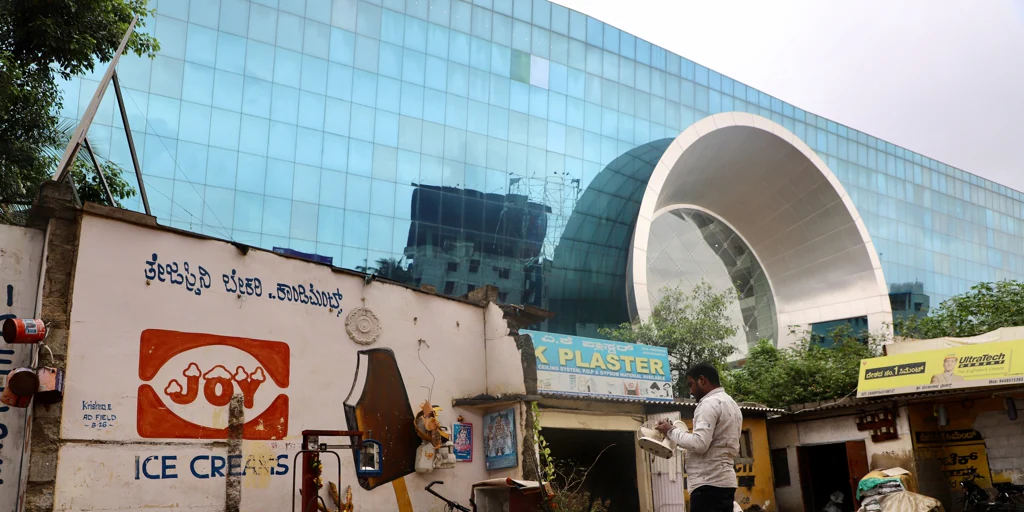In Bangalore's hard drive, the curried "Silicon Valley"

Bangalore is called the "Silicon Valley" of India. Quotes have never been more justified. In the shadow of the futuristic conference center of the technology giant Infosys, a kind of glass spaceship with an oval hole in the center reminiscent of a gigantic washing machine, a junkyard buys rusty iron, old bicycles, leaky drums and everything else by weight. that no longer works. So strident are the contrasts of India, skin deep in Bangalore. Located in the south of India in the state of Karnataka, of which it is the capital, this city of eleven million inhabitants has been the heart of its powerful computer and technology industry for three decades. Its numerous business parks host the data and programming centers of multinationals such as Cisco, Intel, Sony, Honeywell or HSBC. In the early 1990s, when India began to open up its economy, big names like General Electric, Bank of America, Texas Instruments and British Airways moved in here, seeking the cheap labor of its skilled programmers and engineers. Trained in the polytechnic institutes that proliferated in Bangalore in the 1960s and 1970s in the heat of the Indian aeronautical industry, where the brightest young people sought a better future in the midst of so much poverty, many of these programmers and engineers are now magnates who run large Business. Thanks to these engineers and its pleasant climate, Bangalore attracted numerous entrepreneurs to set up their companies here. This is the case of Infosys, which was founded by seven engineers in the city of Pune with a capital of 250 dollars in 1981 and two years later moved its headquarters to Bangalore. Famous for its Finacle finance and accounting software, used by banks around the world, Infosys is India's second largest technology company after the IT division of multinational Tata, its neighbor in the Electronic City park. Related News standard No The dawn of India as a superpower capable of being the alternative to China Innovative companies advance in a country that, due to its growing middle class, its commitment to infrastructure and its technological talent, stands as an emerging giant that will have its weight in the coming years Oasis of prosperity Its modern constructions, such as the glass pyramid of Infosys together with its aforementioned «washing machine», stand out among the humble houses and surrounding shacks, along whose dirt paths cows graze and cluck chickens while the children play barefoot. Amid the chaotic traffic and misery that still abounds in India, the tech industries of Bangalore, Hyderabad, Gurgaon, Pune and Madras (Chennai) offer an oasis of prosperity to the 1.5 million engineers who graduate every year. Their average salaries range from 500 euros per month during the first five years, which allows them to enter a comfortable middle class, to more than 2,000 with two decades of experience. Although they are not too high figures compared to the West, they represent a fortune in a country where 22% of its 1,400 million inhabitants live below the poverty line. A competitiveness that, thanks to their knowledge and command of English, has made Indian engineers unbeatable and propelled this sector. “In 1990, this industry had a revenue of less than a hundred million dollars and 200,000 employees. In fiscal year 2021-2022, and not counting e-commerce, turnover amounted to 227,000 million dollars, of which 178,000 million came from exports and 49,000 million from the domestic market. In addition, there are now 5.1 million direct jobs, which generate three times as many indirect ones. A third of them are occupied by women, since information technology is one of the engines of employment in India, "explains KS Viswanathan, vice president of the Nasscom employers' association, which brings together 3,000 companies in the sector. Already representing 8% of India's Gross Domestic Product (GDP) and a third of its total exports, the exponential growth of this industry accelerated between 2000 and 2010 with globalization and, above all, since 2015 due to the explosion of data on the internet . In 2007, when this correspondent visited Bangalore for the first time, his turnover was ten times less: 27,500 million euros, of which 21,700 corresponded to exports and 5,800 to the domestic market. At that time, the industry directly employed 1.6 million people and contributed 4.7 percent to GDP, half what it is now. Top photo: Quest Global is a leading software company for engineering and machinery and in 2011 it acquired the Spanish firm Interface. Above: left, the young Abhijit Nair developed a smart bracelet three years ago to help the rehabilitation of alcoholics and drug addicts and has founded his own company to market it and, right, Surajit Sinha has created a special "tablet" that looks like paper, and in which students can write, see books and notes and be connected with the teacher and classmates ABC «During that decade progress was made in outsourcing services, as seen in the ˝call-centres˝ that served customers in English . Within their evolution, they are no longer just dedicated to receiving your orders or complaints, but also offer specialized services and have become contact centers to solve problems”, explains KS Viswanathan the change in trend in Bangalore. "In the past, the industry was one-dimensional, but now India is a powerhouse in information technology (IT) services, business process management (BPM) and computer engineering," said Nasscom's vice president. The 5G factor The transformation continues due to the digitization that drives the growth of the internet thanks to 5G, which has not been diminished by the pandemic, quite the opposite. “During the Covid lockdown in the spring of 2020, the industry reinvented itself in just ten days to bring office work home. Before the pandemic, 85% of services came from eight cities. Now we work from 300 places across the country, ”explains Viswanathan. While the Indian economy collapsed 8% in 2020 due to the coronavirus, this industry rose between 2 and 3% and, the following year, grew 15%, double that of GDP. “In a single year, 450,000 employees have joined and the industry is growing even though the economy is falling because technology is everywhere and Covid has shown that you cannot live without it. Without technology, India would not have been able to put more than 2,000 million vaccines to return to normality, ”reasons the Nasscom representative. In his opinion, this trend will increase because “all products and services globally are becoming smart and contactless, which requires more staff and software. For example in automobiles, telecommunications, semiconductors… That is the key to the success of the Indian technology industry”. 22% of the 1,400 million Indians still live below the poverty level This is demonstrated by the trajectory of Quest Global, which designs computer solutions and software for engineering and machines, bills 700 million dollars a year and has 14,000 employees in 17 countries, including Spain. Founded 25 years ago in the United States by Ajit Prabhu, it began as a mechanical engineering company and had General Electric (GE) as one of its first clients. Precisely, the evolution of this multinational marked the destiny of Quest Global, which began to take off between 2001 and 2002, when GE relocated and outsourced some services. Training with scholarships “We realized that we couldn't just be a mechanical engineering company and we had to evolve,” recalls Ajay A. Prabhu, brother of the founder and president of Technological Services. He is one of those engineers who came out of a public polytechnic institute, where you only had to pay 400 rupees (5 euros) for tuition, and then studied with scholarships. With $20 in his pocket, he emigrated to Massachusetts for his Ph.D. in electrical engineering, and after first working at HP, he returned to India and joined Quest in 2002. “At the time we had a small office in Old Bangalore on a durian market”, he recalls, laughing at the bad smell of said fruit, in the company's modern headquarters, to which they moved five years ago, occupying eight of the eleven floors of a rented building in the Embassy Tech Village park. With its engineering analysis and test and failure simulation software, Quest serves major foreign firms in aeronautics, defense, automotive, energy, high-tech, healthcare, railways and semiconductors. In this last field, decisive for the future, the company entered a year and a half ago designing microchips for its clients. “Every machine is becoming smarter and we have diversified into the digital experience,” says Prabhu, who is very pleased with the 2011 acquisition of the Spanish firm Interface. Entrepreneurial drive Trying to follow in the footsteps of Quest Global and other big companies, Bangalore is teeming with young engineers trying to get their projects off the ground. After leaving his position at Cisco Systems in 2018, Surajit Sinha has founded his own company, Snehix, to sell a 'tablet' that looks like paper. “I got the idea when I saw that my son brought a lot of notebooks to class. Unlike other conventional devices such as computers and tablets, this one does not emit any light and its reading is very pleasant for the eyes. With a special application, it can be used in schools and other educational institutions because we have digitized the books and it allows writing with a digital pen just like on paper. In addition, all the devices are connected to each other and to the cloud and can send documents and share the screen », he explains, showing the functions of the device, manufactured by a Taiwanese company. Having received a grant from the state of Karnataka, this 'paper tablet' is being tested in a Bangalore school and, due to the quality of its design and the ease of writing on its screen, it has a bright future ahead of it. The average salary of programmers and computer scientists in Bangalore is 500 euros for the first five years To help young entrepreneurs, many public and private incubators operate in Bangalore. In one of the latter, Ginserv, the young Abhijit Nair has set up his company, called Velectron Labs, to create a smart bracelet that helps in the rehabilitation of alcoholics and drug addicts. “It's called Adictofree and it's a pioneering and unique therapy that helps drug addicts to get off the hook and continue the rehabilitation process. By measuring their vital signs, it gives them an accurate picture of their behavior and risk of relapse and allows them to seek medical assistance before they are tempted to leave rehab," says Nair, who is 25 and designed this bracelet three years ago, when I was still in college. At 33 years old, Saurya Mishra, a former Philips employee, has founded the company Articulus and developed a portable robot for operations on the abdomen and pelvis operated remotely and in 3D by a doctor. Smaller and cheaper than current medical robots, he hopes to bring it out in a couple of years "to reduce healthcare costs." An Incomplete Journey Fifteen years ago, Infosys' “washing machine” was reached via a narrow, pothole-ridden road over which an elevated highway was being built. Already operational, it is a great advance, but it is still just as collapsed by the infernal traffic between the substandard housing that surrounds it. In the midst of brutal contrasts, Bangalore's technology resets poverty in India, but it has as much road ahead as it has already traveled.
Source link









